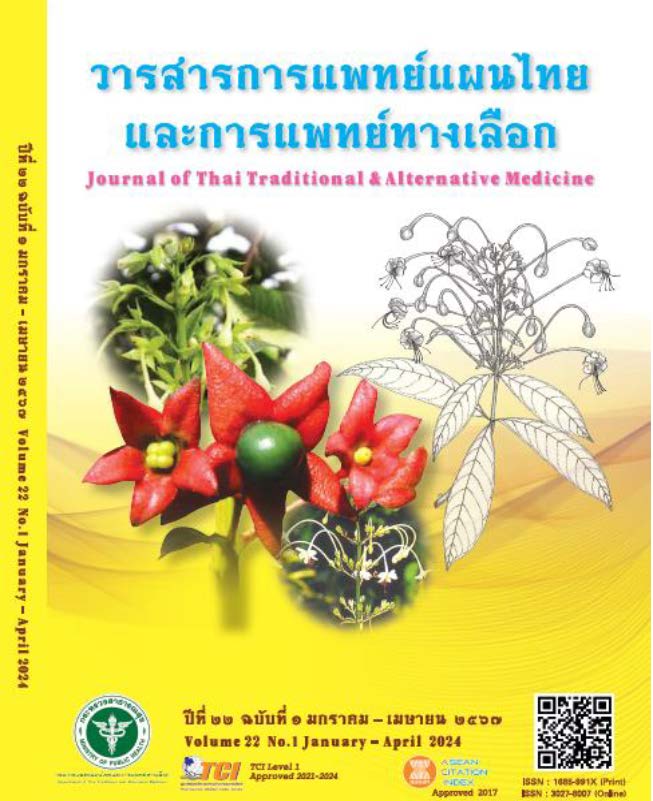Quality Control and Antioxidant Activities of Ya Mor Harak Herbal Formula
Main Article Content
Abstract
Introductions and Objectives: Ya Mor Harak (YMH), a herbal formula, is used for purgative and antipyretic
purposes according to a Subdistrict Traditional Medicine Textbook (Tamra Phaet Tambon, Vol. 3). In the
past, there were no studies on the YMH formula. Therefore, the aims of this study were to identify indicators or markers for quality control of herbs, including phytochemical screening, total phenolic content, chemical identity and antioxidant activities of YMH extracts.
Methods: The YMH extraction was undertaken using three solvents: deionized water (A YMH), 70% ethanol
(70E YMH) and 95% ethanol (95E YMH). The YMH quality control measures included the analyses for moisture,
total ash and acid insoluble ash, as well as YMH extract’s phytochemical screening, chemical identification (using thin layer chromatography, TLC) and antioxidant activity quantification using DPPH, FRAP and ABTS assays.
Results: Alkaloids, terpenoids, anthraquinones and tannins were found in the YMH formula. Its 70E extract
had the highest total phenolic content at 180.92 ± 3.46 mg GAE/g extract and showed the highest antioxidant activities with the DPPH assay at EC50 7.28 ± 0.72 μg/mL and the FRAP assay at 306.81 ± 1.57 mg Trolox/g extract and 486.64 ± 2.49 mg Fe2+/g extract. And the A YMH extract showed the highest elimination of free radical ABTS+•(EC50 = 19.84 ± 4.85 μg/mL), while the chemical identification using TLC found 17 bands on the TLC plate.
Discussion: Aqueous YMH extract showed the best antioxidant activity using the ABTS assay, which was
consistent with the ABTS’ water-soluble property. The 70E YMH extract had the best antioxidant activity with the DPPH assay, which was consistent with the DPPS’ ethanol-soluble property.
Conclusion and Recommendation: A YMH decoction with water imitating the traditional method has
antioxidant activities. In the future, other pharmacological activities and specified chemical identification should be studied for further development of YMH for patient treatments.
Article Details

This work is licensed under a Creative Commons Attribution-NonCommercial-NoDerivatives 4.0 International License.
References
Phrayaphad Pongsa Wisutthatipphadee (Sun Suntorawech). Phadtumbon III (fever). 1927. (in Thai)
Soradech S, Kusolkumbot P, & Thubthimthed S. Development and characterization of microemulsions containing Tiliacora triandra Diels as an active ingredient for antioxidant and melanogenesis stimulating activities. Journal of Applied Pharmaceutical Science. 2018;8(3):046-054.
Nutmakul T. Phytochemical and pharmacological activity of Tiliacora triandra (Colebr.) Diels. Songklanakarin Journal of Science & Technology. 2021;43(5).
Yadav RK, Nandy BC, Maity S, Sarkar S, Saha S. Phytochemistry, pharmacology, toxicology, and clinical trial of Ficus racemosa. Pharmacognosy Reviews. 2015;9(17):73.
Dechayont B, Phuaklee P, Chunthorng-Orn J, Juckmeta T, Prajuabjinda O, Jiraratsatit K. Antibacterial, antiinflammatory and antioxidant activities of Mahanintangtong and its constituent herbs, a formula used in Thai traditional medicine for treating pharyngitis. BMC Complementary Medicine and Therapies. 2021;21(1):1-12.
Jaiwal K, Thakur T, Mishra N, & Kumar A. Pharmacological approach of Terminalia arjuna: A review. Plant Cell Biotechnology and Molecular Biology. 2021;1-15.
Department of Medicine Science, Ministry of Public Health. Thai Herbal Pharmacopoeia 2020 volume I. Office of National Buddishm Press: Bangkok; 2020. (in Thai)
Soonthornchareonnon, N. Medicines and natural products Vols 1. 3rd ed. Bangkok: Sangtian Printing LTD; 2001.116-128.
Miliauskas G, Venskutonis PR, Van Beek TA. Screening of radical scavenging activity of some medicinal and aromatic plant extracts. Food Chemistry. 2004;85(2):231-7.
Liyana-Pathirana CM, Shahidi F. Antioxidant activity of commercial soft and hard wheat (Triticum aestivum L.) as affected by gastric pH conditions. Journal of Agricultural and Food Chemistry. 2005;53(7):2433-40.
Thaipong, K, Boonprakob U, Crosby K, Cisneros-Zevallos L, Byrne DH. Comparison of ABTS, DPPH, FRAP, and ORAC assays for estimating antioxidant activity from guava fruit extracts. Journal of Food Composition and Analysis. 2006;19(6-7):669-75.
Oyedemi SO, Bradley G. Afolayan AJ. In-vitro and -vivo antioxidant activities of aqueous extract of Strychnos henningsii Gilg. African Journal of Pharmacy and Pharmacology. 2010;4(2):70-8.


